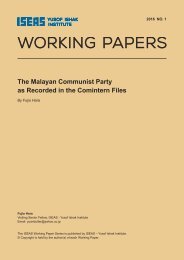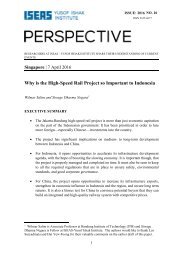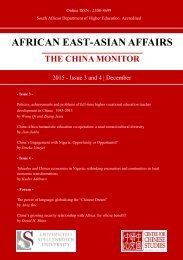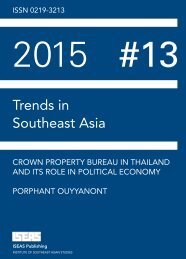NO.19
nscwps19_early_voyaging_south_china_sea_implications_territorial_claims
nscwps19_early_voyaging_south_china_sea_implications_territorial_claims
Create successful ePaper yourself
Turn your PDF publications into a flip-book with our unique Google optimized e-Paper software.
Flecker: Early Voyaging in the South China Sea NSC Working Paper No. 19From the mid-14 th century a new type of vessel makes an appearance. Manguin(1984) first coined the term ‘South China Sea Tradition’ for hybrid vessels which combinedChinese shipbuilding techniques with those of traditional Southeast Asia. Dowel edgejoiningand arguably the keel and V-shaped hull can be attributed to Southeast Asiantraditions. Bulkheads, iron fastenings, the axial rudder, and perhaps the mast-stepfor tabernacle partners are the key contributions of China. The hybrid outcome was amagnificent combination of strength and lightness.Well over 20 South China Sea Tradition wrecks have been found over the past fourdecades, all in Southeast Asian waters. Most were found with cargoes of Thai ceramics,sometimes intact but usually heavily looted. Relatively well-documented wrecks includethe Bukit Jakas Wreck (Manguin 1989), Phu Quoc I Wreck (Blake and Flecker 1994), theCentral Gulf of Thailand Wreck (Flecker 2007), the Ko Kradat Wreck (Green et al. 1984),the Ko Si Chang III Wreck (Green and Harper 1987), the Pataya Wreck (id. 1983), the RoyalNanhai Wreck (Brown and Sjostrand 2002), the Longquan Wreck (ibid.), the NanyangWreck (ibid.), the Santa Cruz Wreck, 31 the Lena Shoal Wreck (Goddio 2002), and thePandanan Wreck (Loviny 1996).Most of these shipwrecks contained Sawankhalok and/or Sukhothai ceramics,along with storage jars from kilns in Suphanburi Province. However, not all South ChinaSea Tradition wrecks contained Thai ceramics. The Santa Cruz ship had a predominantlyChinese ceramic cargo bound for the Philippines or Borneo. Whether it loaded directlyin China, or at an entrepot port in Southeast Asia, is open to speculation. The Pandananship contained mostly Vietnamese ceramics destined for Borneo or Sulawesi. The Hoi AnWreck carried hundreds of thousands of Vietnamese blue-and-white ceramics from theHai Duong kilns, located near the port of Hai Phong. The cargo is particularly importantfor highlighting the skills of the Vietnamese potters, skills perhaps learnt from theirChinese counterparts who migrated south in search of work at the start of the Ming ban.The wreck lies off Cu Lao Cham, half way down the east coast of Vietnam. Apart from thefact that she was headed south, little about her route can be deduced from her position.Vietnamese ceramics are relatively rare in Thailand so another destination in SoutheastAsia is more likely, where, just like Thai ceramics, the Vietnamese product enjoyed a surgein popularity when Chinese private trade was prohibited.A Look at the TrendsData SelectionAs noted above, it can be difficult to determine whether a particular shipwreck was involved indistant voyaging or coastal trade when there is no surviving cargo. Of the multitude of earlylashed-lug craft, it would seem that the Pontian ship was involved in the South China Sea tradedue to the presence of ‘piles of ceramics’, and from the speculated size of the largest Paya Pasirship, that too is likely to have been a long-distance trader. The other vessels were quite likelyinvolved in localised inter-island trade, or they could well have been used for fishing, piracyor battle. They would have been covering distances comparable to the Chinese coastal andriverine traders, although the seas in the higher latitudes would tend to be more tempestuous.31 http://www.franckgoddio.org/projects/ancient-trade-routes/santa-cruz.html38








